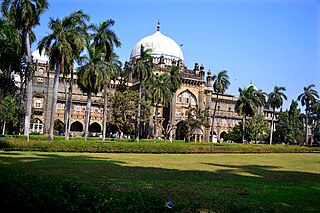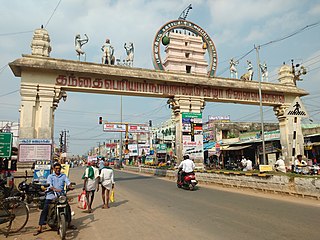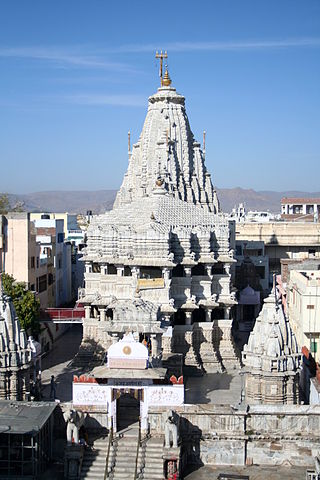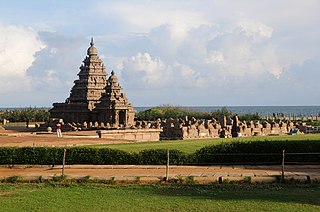Related Research Articles

Chhatrapati Shivaji Maharaj Vastu Sangrahalaya, (CSMVS) formerly named Prince of Wales Museum of Western India, is a museum in Mumbai (Bombay) which documents the history of India from prehistoric to modern times.

Panruti is a town, municipality and taluk headquarters of Cuddalore district, Tamil Nadu, India. Panruti is located between Cuddalore and Neyveli. Panruti is famous for jackfruits and cashew nuts. The jackfruit grown here is exported worldwide and is very sweet. It is a business capital of Cuddalore district. Kananchavadi one of the villages in panruti taluk, famous for palm juice. It has been a great commercial area for more than 200 years. The name Panruti came from the Tamil words "Pann" and "Urutti" meaning "composing song and music", as the place is where many saints and great religious singers such as nayanmars and vainavas sung. A 150-year-old government school was built here by the British East India Company and a more-than-1000-year-old temple Veerattaneswarar temple is nearby in Thiruvathigai. As of 2011, the town had a population of 60,323.

Silver Beach is a beach on the southeast coast of India. It is located 2 km (1.2 mi) from downtown Cuddalore, the headquarters of Cuddalore district in the state of Tamil Nadu. Silver Beach, however, is untouched by the busy life of the city. It is the second longest beach on the Coromandel Coast and one of the longest beaches in Asia. The 57 km-long stretch of beach faces severe seafront erosion.

The Government Museum, Chennai, or the Madras Museum, is a museum of human history and culture located in the Government Museum Complex in the neighbourhood of Egmore in Chennai, India. Started in 1851, it is the second oldest museum in India after the Indian Museum in Kolkata. It is particularly rich in archaeological and numismatic collections. It has among the largest collection of Roman antiquities outside Europe, peculiarly in the numismatics field, and is very likely the most richly endowed museum in Asia concerning this civilisation. Among them, the colossal Museum Theatre is one of the most impressive. The National Art Gallery is also present in the museum premises. Built in Indo-Saracenic style, it houses rare European and Asian painting of renowned artists, including that of Raja Ravi Varma. It had 0.6 million visitors in 2018. It has the richest collections of bronze idols, 500 of them dating to 1000 BCE, in Asia.

The Great Living Chola Temples is a UNESCO World Heritage Site designation for a group of Chola dynasty era Hindu temples in the Indian state of Tamil Nadu. The temple at Thanjavur was added in the list in 1987, while the other two temples were added in 2004.

The period of the imperial Cholas in South India was an age of continuous improvement and refinement of Chola art and architecture. They utilised the wealth earned through their extensive conquests in building long-lasting stone temples and exquisite bronze sculptures, in an almost exclusively Hindu cultural setting.

The National Museum in New Delhi, also known as the National Museum of India, is one of the largest museums in India. Established in 1949, it holds a variety of articles ranging from pre-historic era to modern works of art. It functions under the Ministry of Culture, Government of India. The museum is situated on Janpath. The blue–print of the National Museum had been prepared by the Gwyer Committee set up by the Government of India in 1946. The museum has around 200,000 works of art, mostly Indian, but some of foreign origin, covering over 5,000 years.

National Museum, located at the base of Swayambhu, a sacred hill in the Kathmandu Valley, is the first Nepalese museum. Covering an area of approximately 50 Ropani, the museum comprises various buildings, gardens, and open spaces within its premises. Its primary function is to preserve and exhibit rare and valuable art treasures.
Ariyankuppam is a Town, Commune, Sub-Taluk, and Assembly Constituency in the Union Territory of Puducherry, India. The streets in Ariyankuppam are straight and in grid form, similar to Puducherry boulevard.
Hindu art encompasses the artistic traditions and styles culturally connected to Hinduism and have a long history of religious association with Hindu scriptures, rituals and worship.

Goa State Museum, also known as the State Archaeology Museum, Panaji, is a museum in Goa, India. Established in 1977, it contains departments including Ancient History and Archaeology, Art and Craft, and Geology. The museum, as of 2008, had about 8,000 artifacts on display, including stone sculptures, wooden objects, carvings, bronzes, paintings, manuscripts, rare coins, and anthropological objects. Currently, the Museum is located at the Adil Shah's Palace in Panaji. The Museum's erstwhile premises at the EDC Complex in Patto, Panaji shall be demolished to make way for a new Museum building.

Visakha Museum is a museum located in the port city of Visakhapatnam in Andhra Pradesh, India, which houses the historical treasures and artifacts of the Kalingandhra region. It was inaugurated by the then Chief Minister of Andhra Pradesh N. Janardhana Reddy on October 8, 1991, owned by Government of India.

Jagdish Temple is a large Hindu temple in the middle of Udaipur in Rajasthan, just outside the royal palace. It has been in continuous worship since 1651. A big tourist attraction, the temple was originally called the temple of Jagannath Rai but is now called Jagdish-ji. It is a major monument in Udaipur.

Government Museum, Mathura, commonly referred to as Mathura museum, is an archaeological museum in Mathura city of Uttar Pradesh state in India. The museum was founded by then collector of the Mathura district, Sir F. S. Growse in 1874. Initially, it was known as Curzon Museum of Archaeology, then Archaeology Museum, Mathura, and finally changed to the Government Museum, Mathura.

Srivaikuntanathan Perumal Temple in Srivaikuntam, a town in Thoothukudi district in the South Indian state of Tamil Nadu, is dedicated to the Hindu god Vishnu. It is located 22 km from Tirunelveli. Constructed in the Tamil style of architecture, the temple is glorified in the Nalayira Divya Prabandham, the early medieval Tamil canon of the Alvar saints from the 6th–9th centuries CE. It is one of the 108 Divya Desams dedicated to Vishnu, who is worshipped as Vaikunthanathar and his consort Lakshmi as Vaikunthavalli. The temple is also classified as a Nava Tirupati, the nine temples revered by Nammalvar located in the banks of Tamiraparani river. The temple is next only to Alwarthirunagari Temple in terms of importance among the nine Navatirupathi temple. The temple is one of the Navagraha temples in Vaishnavism, associated with Surya, the sun god.

Chakrapani Temple is a Hindu temple dedicated to God Vishnu located in Kumbakonam, Tamil Nadu, India. This temple is located 2 km, away towards North West from the Kumbakonam Railway Station. Vishnu appears in the form of a discus or Chakra to put down the pride of Surya, who subsequently became his devotee. Like Shiva, Lord Chakrapani has a third eye on His forehead. The temple is one of the most prominent temples in Kumbakonam.

The Group of Monuments at Mahabalipuram is a collection of 7th- and 8th-century CE religious monuments in the coastal resort town of Mahabalipuram, Tamil Nadu, India and is a UNESCO World Heritage Site. It is on the Coromandel Coast of the Bay of Bengal, about 60 kilometres (37 mi) south of Chennai.

The Nagpur Central Museum, popularly known as Ajab Bangala, is located in Nagpur, Maharashtra, India. Established in 1863, Nagpur Central Museum is one of the oldest museums in India and Maharashtra. It holds important artifacts such as dinosaurs' fossils, coins, ancient inscriptions, sculptures, arms, tribal artifacts from per-historic to the modern time. The Nagpur Central Museum is the oldest and largest museum in the Central India region.

The Government Museum, Tiruchirappalli is a heritage centre at Tiruchirappalli, Tamil Nadu.It is situated at Rani Mangammal Mahal in Bharathidasan town, near the super bazaar. The nearest landmark is Rockfort temple.

The Art of Mathura refers to a particular school of Indian art, almost entirely surviving in the form of sculpture, starting in the 2nd century BCE, which centered on the city of Mathura, in central northern India, during a period in which Buddhism, Jainism together with Hinduism flourished in India. Mathura "was the first artistic center to produce devotional icons for all the three faiths", and the pre-eminent center of religious artistic expression in India at least until the Gupta period, and was influential throughout the sub-continent.
References
- ↑ "Cuddalore". govtmuseumchennai.org. Retrieved 17 June 2024.
This article relies largely or entirely on a single source .(June 2024) |